Step into a world where cascading braids meet jeweled circlets and flowing tresses speak of royal elegance.
Medieval hairstyles for princesses weren’t merely fashion statements—they were symbols of nobility, femininity, and power that transformed ordinary women into figures of legend.
Whether you’re preparing for a Renaissance faire, a themed wedding, a costume party, or simply seeking inspiration from history’s most romantic era, 27 Creative Medieval Hairstyle Ideas for Princesses offers a treasure trove of authentic and imaginative styles.
From the simple beauty of loose waves adorned with floral crowns to the intricate artistry of multi-strand braids woven with ribbons and pearls, this comprehensive guide explores hairstyles that defined centuries of royal courts across Europe.
You’ll discover how medieval noblewomen used their hair as a canvas for creativity, status, and cultural expression, along with practical techniques to recreate these timeless looks for modern occasions.
Each style in this collection has been carefully curated to capture the essence of medieval romance while remaining achievable for contemporary enthusiasts, ensuring that the magic of princess hair is within everyone’s reach.
Contents
- 1 1. The Classic Crown Braid
- 2 2. Long Flowing Tresses with a Circlet
- 3 3. Double Braids with Ribbon Weaving
- 4 4. The Hennin Hairstyle with Veil
- 5 5. Side-Swept Braid with Flowers
- 6 6. The Wimple and Veil Combination
- 7 7. Braided Updo with Pearl Accents
- 8 8. The Heraldic Hair Net
- 9 9. Half-Up Crown with Loose Curls
- 10 10. The Fillet and Barbette
- 11 11. Mermaid Braid with Jeweled Strands
- 12 12. Coiled Temple Braids
- 13 13. The Caul Hairstyle
- 14 14. Waterfall Braid with Loose Waves
- 15 15. The Butterly Headdress Style
- 16 16. Multi-Strand Micro Braids
- 17 17. The Rose Braid Bun
- 18 18. Crowned Fishtail Braid
- 19 19. The Crispinette Net
- 20 20. Half-Braided Crown with Veil
- 21 21. Twisted Rope Braid
- 22 22. The Templeresses Style
- 23 23. Flower Crown with Braided Accents
- 24 24. The Reticulated Headdress
- 25 25. Braided Headband with Loose Tresses
- 26 26. The Burgundian Turban Style
- 27 27. Asymmetrical Braided Updo
- 28 Conclusion
1. The Classic Crown Braid

The crown braid encircles the head like a natural tiara, creating an instantly regal appearance that medieval princesses adored for formal court appearances.
- This timeless style involves braiding the hair around the perimeter of the head, creating a woven crown effect that sits elegantly at the hairline.
- The crown braid works beautifully with both thick and medium hair textures, providing a secure style that lasts throughout long ceremonial events.
- Medieval noblewomen often enhanced this look with thin gold chains or delicate ribbons woven through the braid.
- Modern adaptations can include adding small flowers, pearls, or decorative pins at intervals along the braid for extra embellishment.
- This hairstyle pairs perfectly with a jeweled circlet placed just above the braided crown for maximum princess impact.
2. Long Flowing Tresses with a Circlet
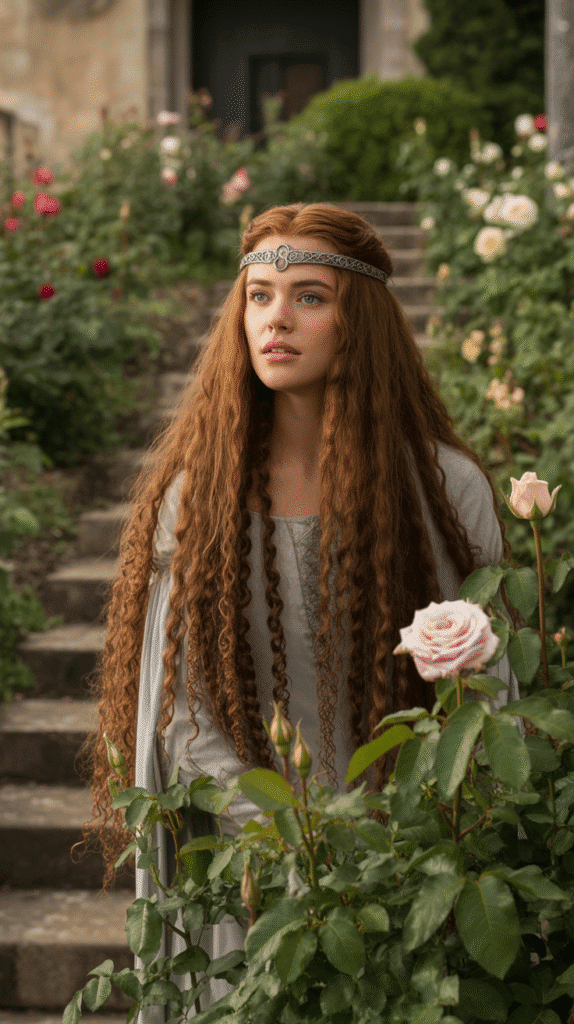
Loose, flowing hair symbolized youth and maiden status in medieval times, making it the quintessential princess look for unmarried noblewomen.
- This effortless style showcases long, natural hair worn completely down with gentle waves cascading past the shoulders.
- A decorative circlet or simple metal band placed across the forehead serves as the only adornment, keeping hair away from the face.
- Medieval princesses often applied herbal rinses made from chamomile or rosemary to enhance shine and fragrance.
- The style works best with hair that has natural body or has been lightly curled with modern tools for added texture.
- Pairing this look with a flowing gown creates the iconic storybook princess silhouette recognized across cultures.
3. Double Braids with Ribbon Weaving
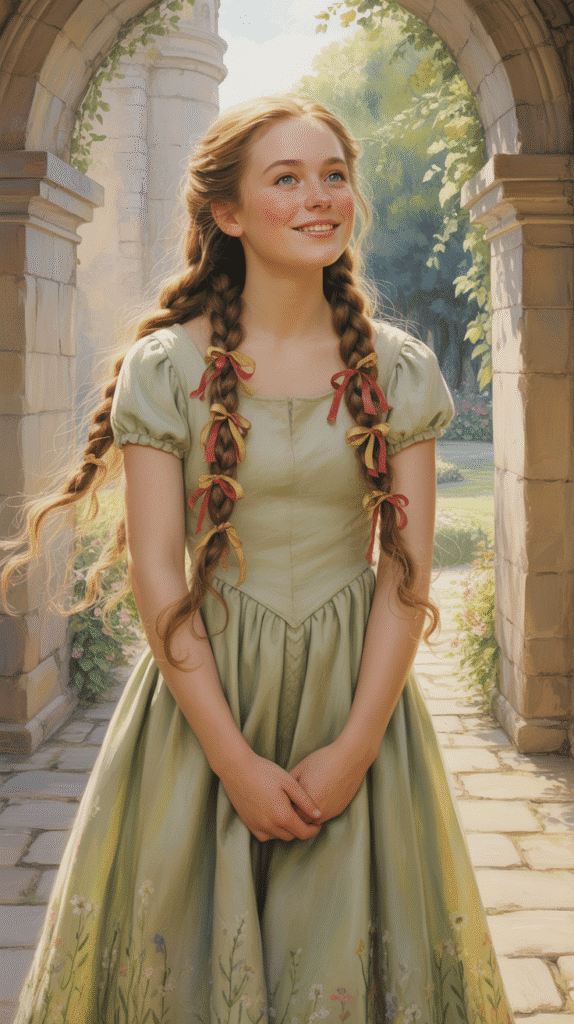
Twin braids interwoven with colorful ribbons created a youthful, playful look favored by younger princesses and noble daughters throughout medieval Europe.
- Two separate braids frame the face and hang down either side, with ribbons woven throughout the length for added color and texture.
- This practical style kept hair secure during horseback riding, hawking, and other active pursuits enjoyed by medieval nobility.
- Ribbon colors often held significance, with family colors or symbolic hues (red for passion, blue for loyalty) chosen deliberately.
- The braids can be tied at the ends with matching ribbons, leaving decorative tails that swing with movement.
- For formal occasions, small bells or charms were sometimes attached to the ribbon ends, creating gentle tinkling sounds.
4. The Hennin Hairstyle with Veil
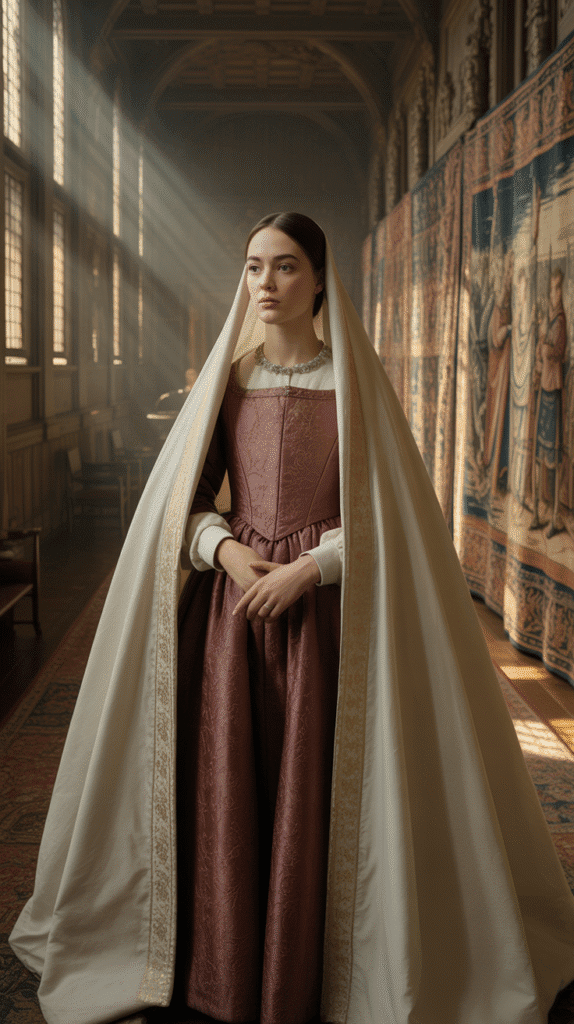
The hennin, a tall conical headdress, required specific hair arrangements that became iconic symbols of late medieval and early Renaissance fashion.
- Hair was typically pulled back very smoothly and tucked completely under or around the hennin structure for a sleek, elegant silhouette.
- A sheer veil attached to the hennin’s point flowed down the back, adding drama and movement to the overall appearance.
- This sophisticated style was reserved for married noblewomen and high-ranking princesses at formal court functions.
- The height of the hennin often indicated social status, with taller versions reserved for queens and princesses of the highest rank.
- Creating this look today requires securing hair in a tight low bun or multiple pin curls before positioning the hennin structure.
5. Side-Swept Braid with Flowers
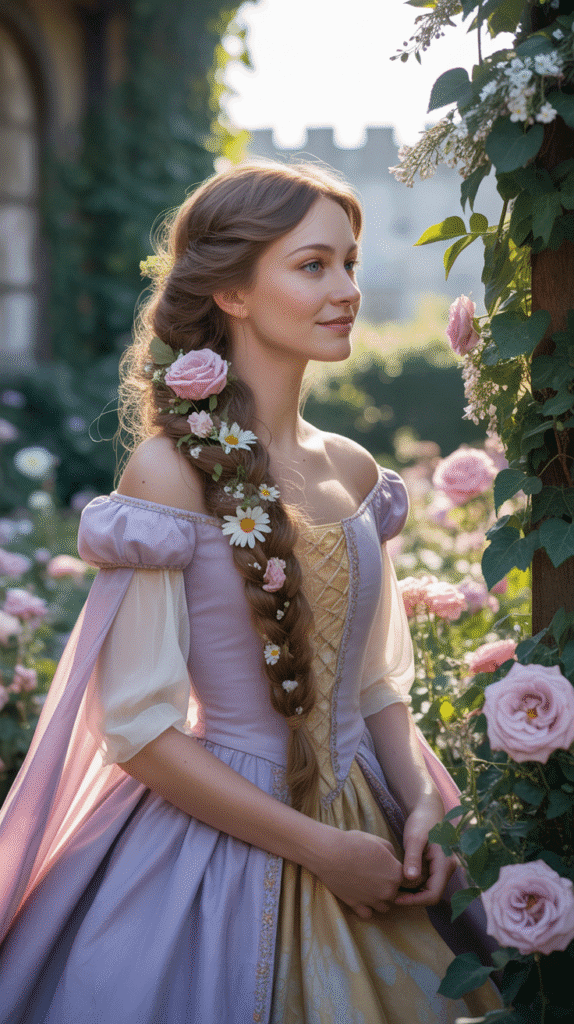
A single thick braid draped over one shoulder and adorned with fresh flowers creates a romantic, feminine look perfect for garden parties and celebrations.
- All hair is gathered to one side and braided into a single plait that rests on the shoulder and chest area.
- Fresh flowers—roses, daisies, lavender, or seasonal blooms—are tucked into the braid at regular intervals.
- Medieval maidens chose flowers with symbolic meanings: roses for love, rosemary for remembrance, violets for faithfulness.
- This asymmetrical style creates visual interest and allows the braid to become a focal point of the overall appearance.
- The look works beautifully for outdoor medieval-themed weddings or spring and summer Renaissance festivals.
6. The Wimple and Veil Combination
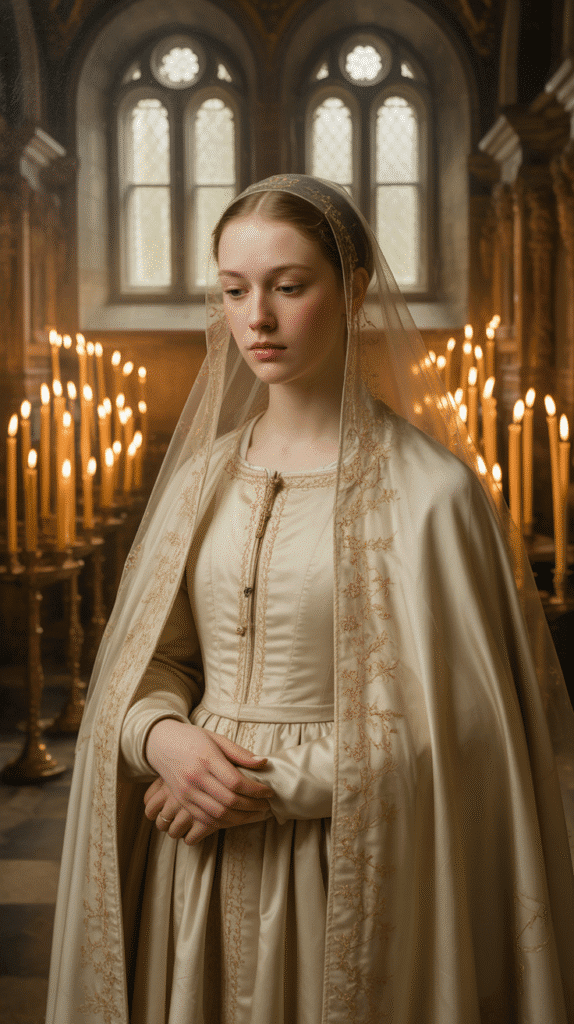
The wimple covered the neck and chin while the veil covered the hair, creating the modest yet elegant look of married medieval noblewomen and queens.
- This conservative style completely concealed the hair beneath layers of fine linen or silk fabric wrapped around the head and neck.
- The wimple portion framed the face while providing full coverage of the neck and throat area.
- A separate veil piece draped over the crown of the head, often secured with pins or a small circlet.
- Different regions developed distinct wimple styles—some closer to the face, others more loosely draped for comfort.
- Though modest, wealthy women adorned their wimples with embroidery, lace edges, or jeweled pins for added luxury.
7. Braided Updo with Pearl Accents
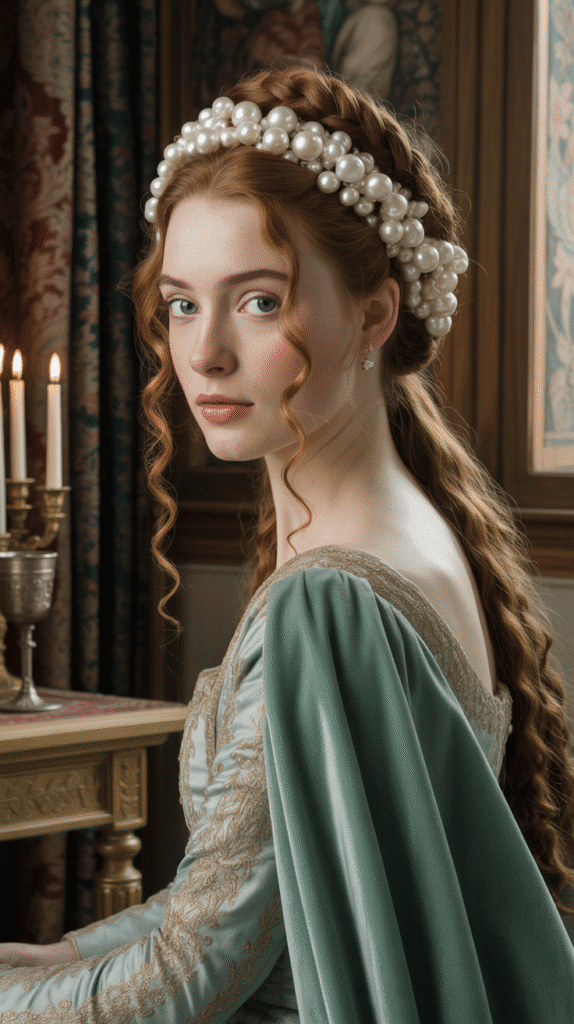
An elaborate updo featuring multiple braids pinned into an intricate pattern and decorated with pearls represented the height of medieval sophistication.
- Several smaller braids are created and then artfully pinned and twisted into an elegant updo at the back of the head.
- Pearls—symbols of purity and wealth—are sewn onto thin threads and woven through the braids or pinned individually throughout the style.
- This complex hairstyle required the assistance of skilled ladies’ maids and could take over an hour to complete.
- The style kept hair completely off the neck and face, making it practical for warm weather and formal indoor events.
- Gold or silver hairpins with decorative tops were used both functionally and as additional ornamentation.
8. The Heraldic Hair Net
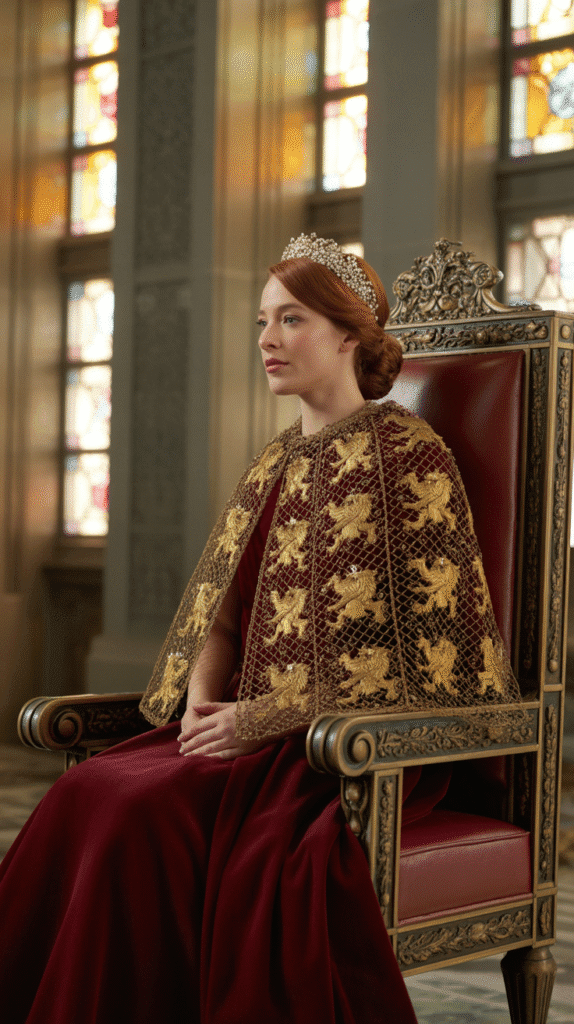
Decorative hair nets made from gold or silver thread, often featuring heraldic designs, encased elaborate hairstyles while displaying family allegiances.
- Hair was arranged in a bun, coiled braids, or other updo, then completely covered with an ornate metallic net.
- The finest examples featured family crests, emblems, or patterns worked directly into the net’s design.
- Small jewels or beads were sometimes incorporated at the net’s intersections, creating a glittering effect.
- This style secured hair completely while allowing the wearer to display wealth through the precious metals used.
- The hair net was often paired with a circlet or small crown worn above it for added royal presence.
9. Half-Up Crown with Loose Curls
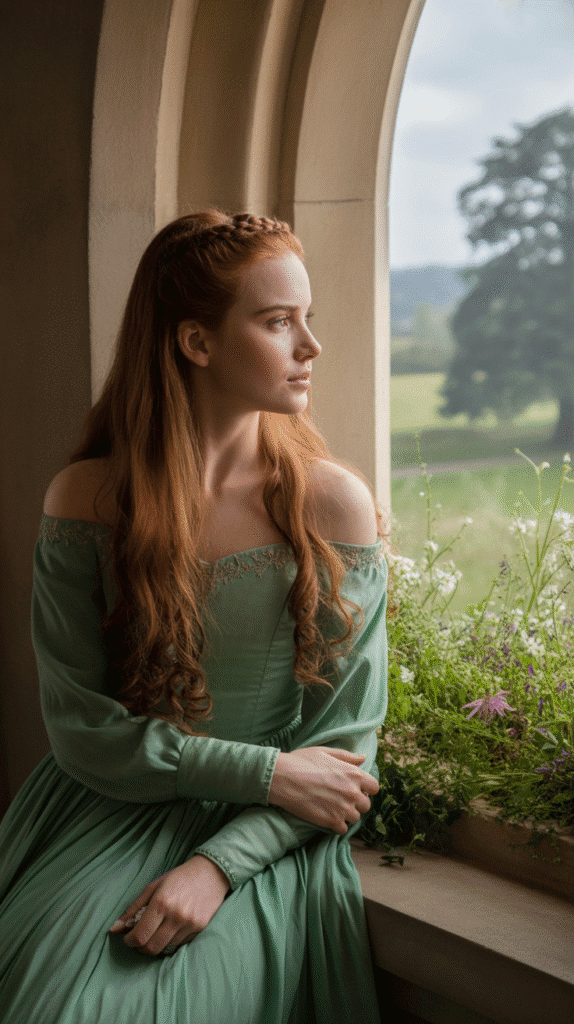
Combining the modesty of pinned-back hair with the youthful appeal of flowing locks, this style offered the best of both medieval aesthetics.
- The top half of the hair is gathered and secured at the crown with pins, braids, or decorative clips.
- The remaining hair flows freely down the back in natural or enhanced curls and waves.
- A small braid can be created from the gathered section and wrapped around itself to form a top-knot.
- Decorative elements like small flowers, ribbons, or jeweled pins adorned the gathered section.
- This versatile style worked for both formal court appearances and casual daily wear among noble households.
10. The Fillet and Barbette
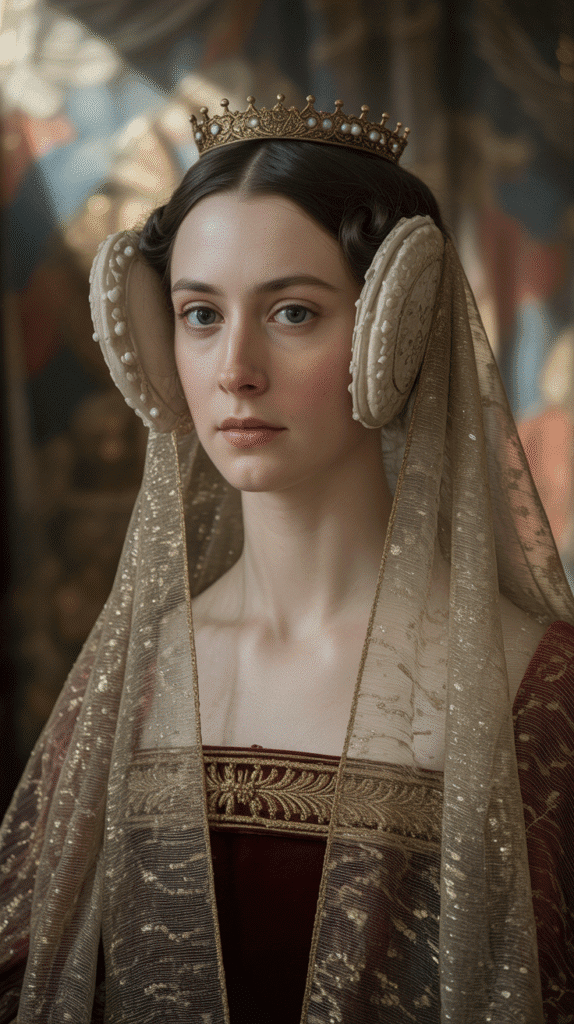
This architectural hair arrangement used padded rolls and bands to create dramatic shapes beneath veils and crowns.
- Hair was arranged over cylindrical pads or rolls (fillets) positioned at the temples or around the head.
- A barbette—a linen band passing under the chin—held everything secure while creating the distinctive medieval profile.
- The resulting shape provided a foundation for veils, crowns, and other head coverings to rest upon.
- This style was particularly popular in the 13th and 14th centuries among the highest-ranking noblewomen.
- Creating the look required expertise in positioning the padding to achieve symmetrical, balanced proportions.
11. Mermaid Braid with Jeweled Strands
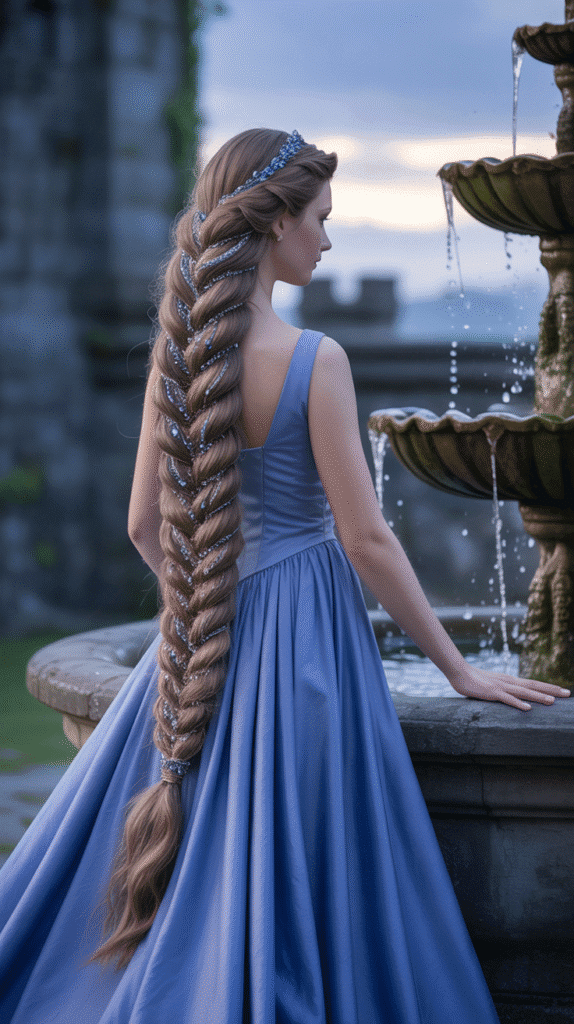
A thick, textured braid resembling a mermaid’s tail, enhanced with jeweled chains woven throughout, created a fairytale princess appearance.
- The hair is braided using a pull-through or ladder braid technique that creates a chunky, dimensional effect.
- Thin chains featuring small gems, crystals, or beads are woven through sections of the braid.
- This romantic style evokes both medieval craftsmanship and mythical beauty, perfect for fantasy-themed events.
- The braid can be worn down the back or brought forward over one shoulder for display.
- Adding ribbons along with the jeweled strands creates additional texture and color variation.
12. Coiled Temple Braids
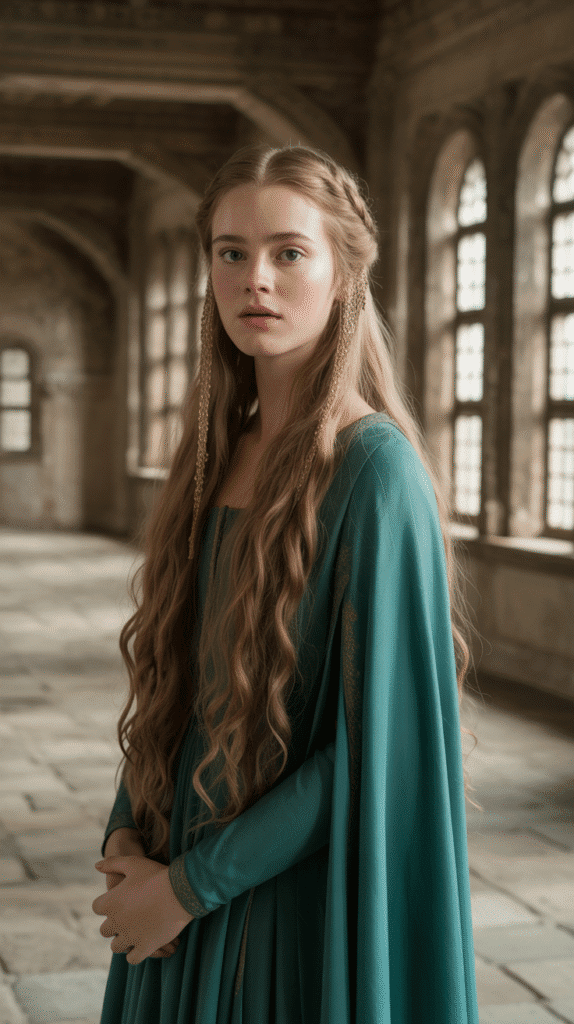
Two braids coiled at the temples created the distinctive “ram’s horn” or “princess leia” style seen in various medieval artworks and manuscripts.
- Hair is parted down the middle, and each section is braided and then coiled into a spiral shape at the temples.
- The coils are secured with pins and sometimes enclosed in decorative nets or cages made of gold thread.
- This symmetrical style framed the face beautifully and was favored in Germanic and Scandinavian medieval regions.
- Ribbons or small flowers could be worked into the braids before coiling for additional ornamentation.
- The style kept hair completely off the face and neck, making it practical for warm weather.
13. The Caul Hairstyle
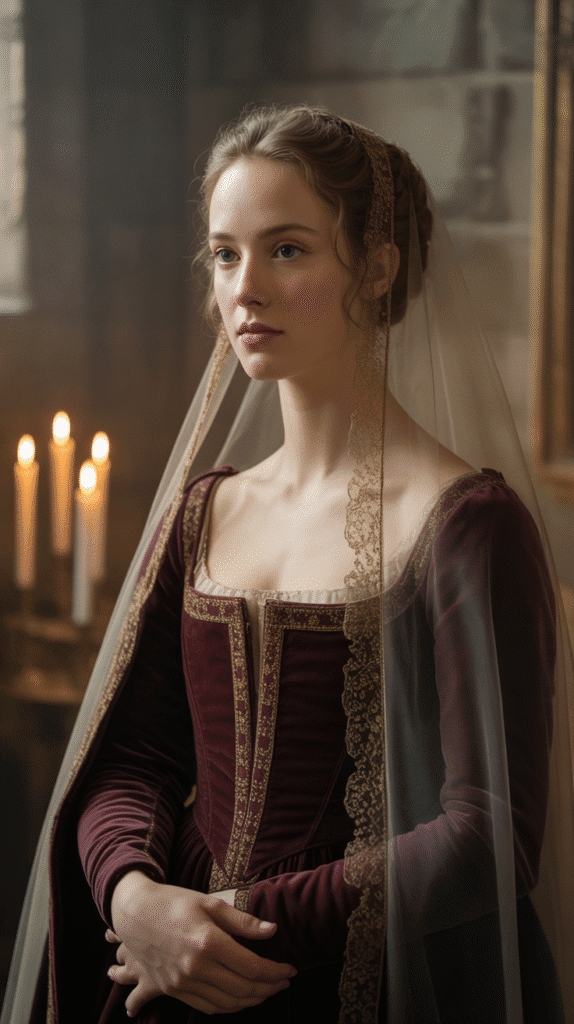
Decorative fabric or net pouches called cauls encased braided or coiled hair at the sides of the head, creating distinctive rounded shapes.
- Hair was divided into two sections, each braided and coiled, then placed into fabric or net cauls at ear level.
- The cauls were often richly embroidered, made from luxurious materials like velvet or brocade, and sometimes jeweled.
- This style created the characteristic “ear muff” silhouette seen in many 14th and 15th-century portraits.
- A veil or small crown could be worn above the cauls for formal occasions.
- Different shapes of cauls—rounded, cylindrical, or flattened—created varying fashionable silhouettes.
14. Waterfall Braid with Loose Waves
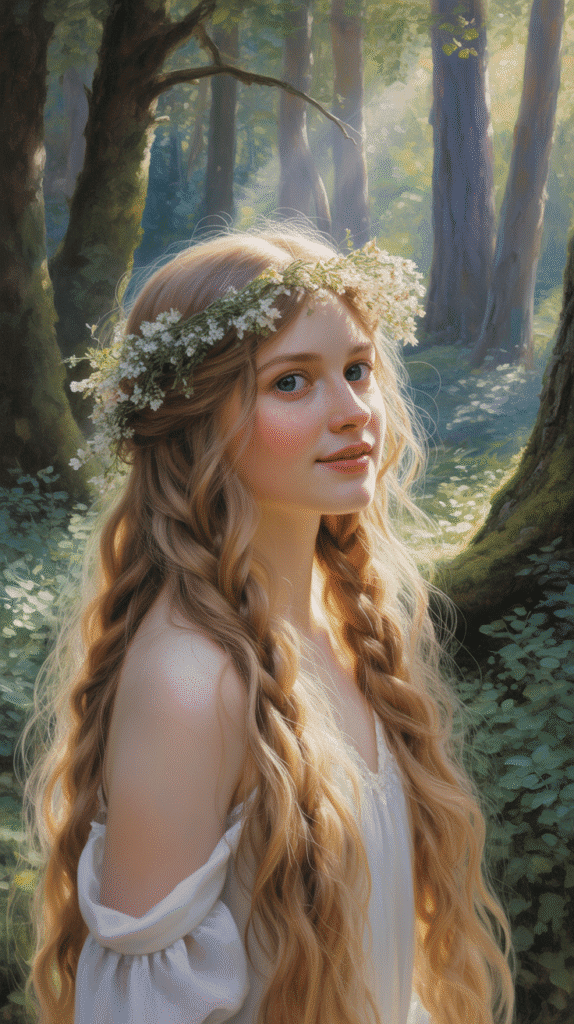
The waterfall braid technique creates a cascading effect with strands of hair appearing to flow through the braid like water over stones.
- A French braid is created along the crown, but with each crossing, a strand is dropped and a new strand picked up.
- The dropped strands create a beautiful waterfall effect cascading down through the braid and into the loose hair below.
- This romantic style combines the structure of braiding with the softness of flowing hair.
- Medieval interpretations often included small flowers or pearls clipped to the dropped strands.
- The style works best with hair that has natural wave or has been lightly curled for enhanced texture.
15. The Butterly Headdress Style
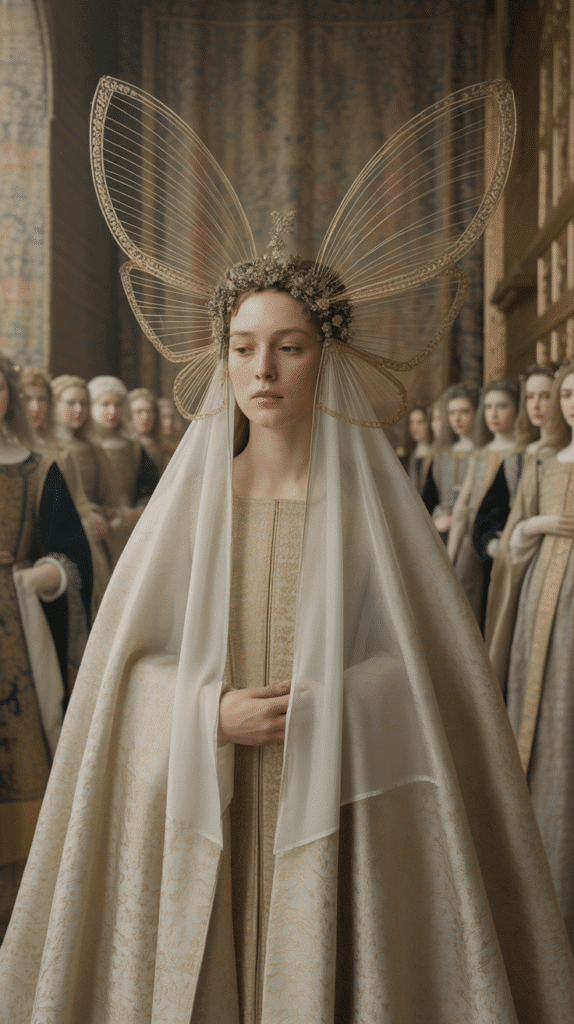
This elaborate 15th-century fashion featured dramatic wire or wicker frames extending from the head like butterfly wings, with hair arranged beneath.
- Hair was smoothed back tightly and often completely hidden beneath the elaborate headdress structure.
- The characteristic “butterfly” or “steeple” shapes extended outward from the temples or upward from the crown.
- Sheer veils or fabrics were stretched across the wire frames, creating dramatic geometric shapes.
- This avant-garde style was popular among Burgundian and Flemish nobility during the height of medieval fashion.
- The most extreme versions could span over a foot wide, making doorways challenging to navigate.
16. Multi-Strand Micro Braids
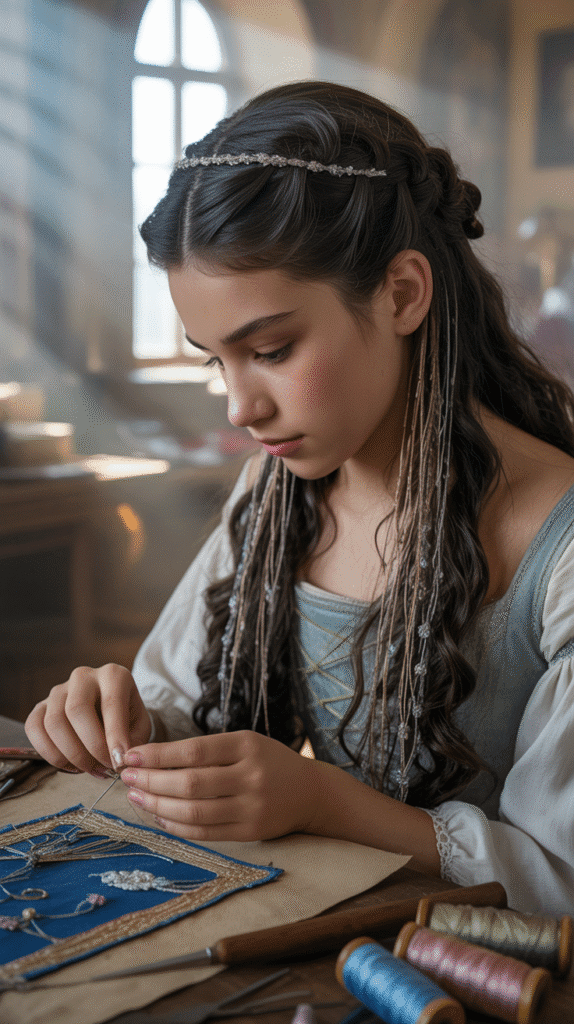
Numerous tiny braids created throughout the hair added incredible texture and detail, often partially gathered or left completely loose.
- Multiple small braids—anywhere from 10 to 50 or more—are created throughout the hair using thin sections.
- Some braids can be left hanging while others are incorporated into larger braids or updos for variation.
- This labor-intensive style showcased the skill of ladies’ maids and the luxury of time available to nobility.
- Small beads, thin ribbons, or threads were often woven into individual micro braids for embellishment.
- The style provided both visual interest and practical hair management, keeping hair tangle-free for days.
17. The Rose Braid Bun
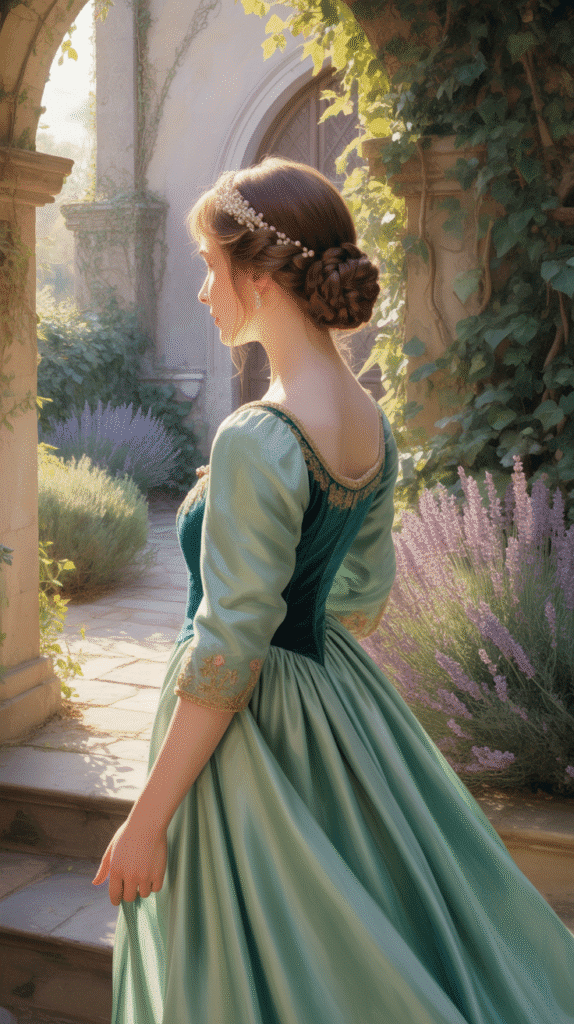
Hair is braided and coiled into a spiral that resembles a blooming rose, creating an elegant and romantic updo.
- A single long braid is created and then coiled around itself in a circular pattern, building from center outward.
- The coiling technique creates natural “petals” that mimic the appearance of a rose flower.
- This sophisticated bun is typically positioned at the nape of the neck or slightly to one side.
- Decorative pins with pearl or jeweled tops can be inserted to represent morning dew on the “rose.”
- The style works beautifully for weddings, formal medieval events, and romantic photo sessions.
18. Crowned Fishtail Braid
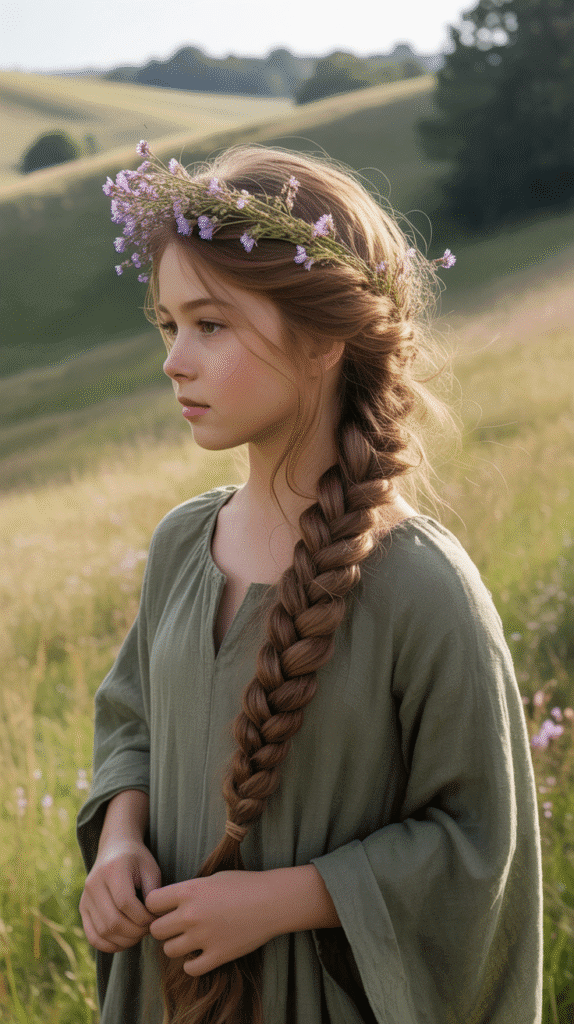
The fishtail braiding technique creates a distinctive herringbone pattern that looks especially regal when wrapped around the head like a crown.
- Hair is divided into two sections, and small pieces are alternately crossed over from one section to the other.
- The resulting braid has a flatter, more intricate appearance than traditional three-strand braids.
- When wrapped around the head crown-style, the fishtail pattern creates a stunning woven texture.
- This style can be enhanced with small flowers, pearls, or thin ribbons worked into the braid.
- The technique works best with long hair and creates a secure style perfect for active medieval activities.
19. The Crispinette Net
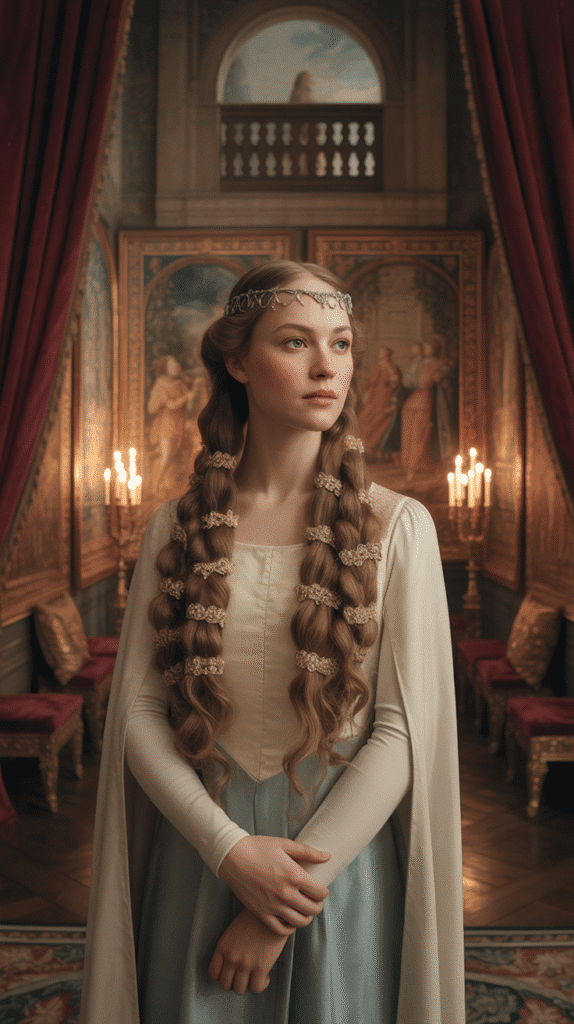
Decorative nets made from silk, gold thread, or fine crochet enclosed braids or coils, creating refined capsule shapes at the sides of the head.
- Hair was braided or twisted and placed into elongated net bags positioned at ear level or slightly behind.
- The crispinette nets were often made from precious materials and could be heavily jeweled or embroidered.
- This style created an elegant silhouette while keeping hair completely secured and manageable.
- Different net shapes—cylindrical, rounded, or flattened—followed changing fashion trends across decades.
- A circlet or crown could be worn above the nets for royal occasions.
20. Half-Braided Crown with Veil
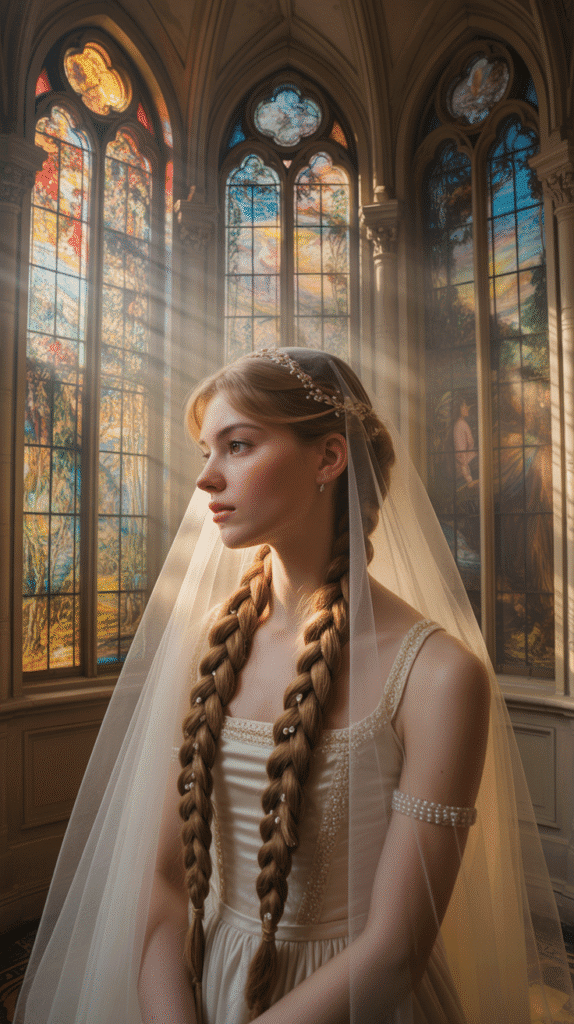
A braid wrapping around only half the head, combined with a flowing veil, created an asymmetrical and dramatic medieval look.
- A braid begins at one temple, wraps across the crown, and ends at the opposite temple or behind the ear.
- The remaining hair can be left loose, partially braided, or tucked beneath the veil.
- A sheer or opaque veil attached at the crown flows down the back, adding movement and drama.
- This style balanced the modesty of covered hair with the beauty of visible braided work.
- Decorative pins or brooches could secure the veil where it met the braid.
21. Twisted Rope Braid
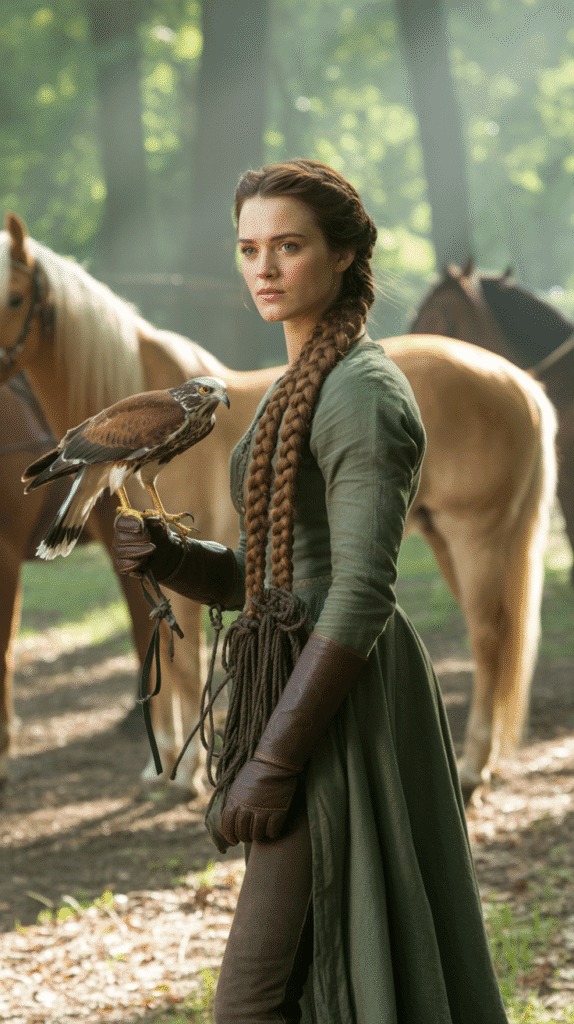
Two or three sections of hair are twisted individually and then wrapped around each other, creating a rope-like textured braid.
- Each section is twisted in the same direction, then the sections are wrapped around each other in the opposite direction.
- This creates a tightly woven rope appearance that’s both sturdy and visually interesting.
- Medieval noblewomen used this technique for braids that needed to withstand long days and physical activity.
- Ribbons or thin leather cords could be twisted along with the hair sections for added decoration.
- The rope braid could be worn as a single long braid down the back or wrapped around the head.
22. The Templeresses Style
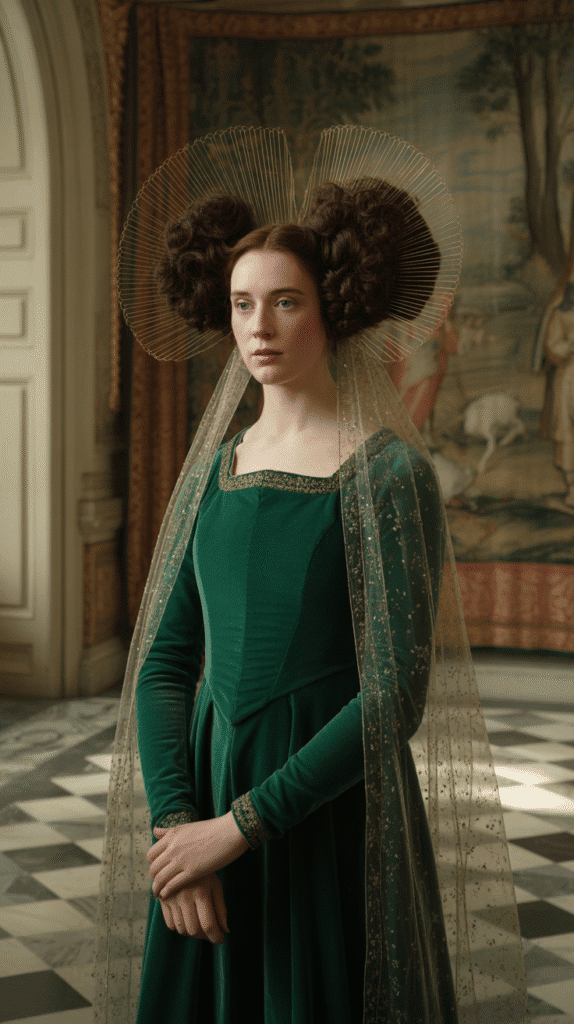
Decorative padded rolls or cylinders positioned at the temples created dramatic width and provided foundation for veils and other head coverings.
- Hair was smoothed over padded forms placed at each temple, creating distinctive horizontal projections.
- The padding was covered with the hair itself or with matching fabric before veils were added.
- This architectural style created a dramatic, wide silhouette popular in certain medieval decades.
- The look required careful balancing and numerous pins to keep the padded forms securely positioned.
- Veils draped over the temple pieces created flowing lines from the widest points.
23. Flower Crown with Braided Accents
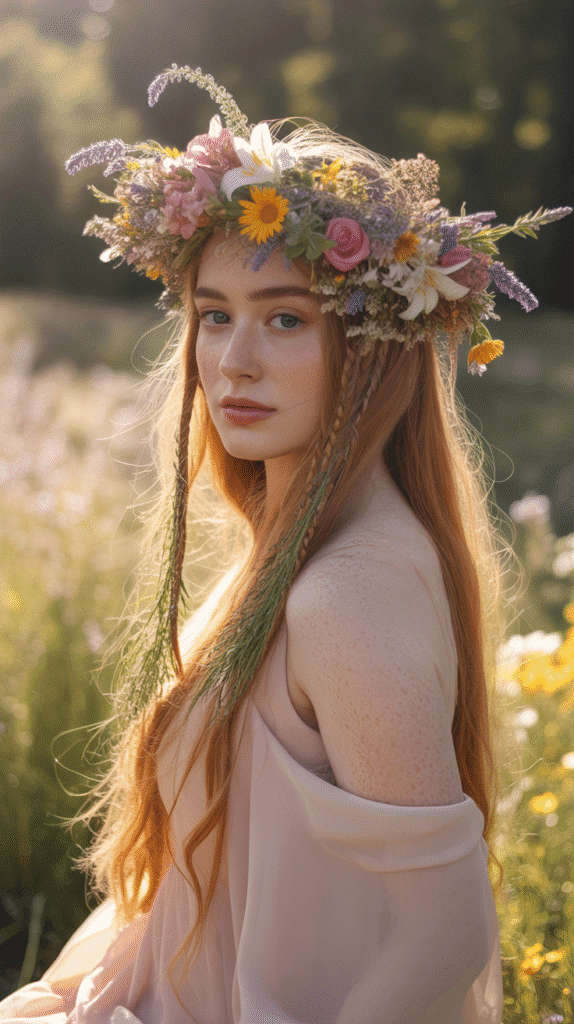
A fresh flower crown combined with small braided sections creates the quintessential medieval maiden look for outdoor celebrations.
- The main hair can be left loose or lightly waved, with a few small braids created near the face or throughout.
- A wreath of fresh seasonal flowers sits atop the head like a natural crown.
- Medieval flower crowns used symbolically significant blooms and greenery based on the occasion.
- The small braids add texture and medieval authenticity to what might otherwise seem too simple.
- This style is perfect for May Day celebrations, handfasting ceremonies, or spring festivals.
24. The Reticulated Headdress
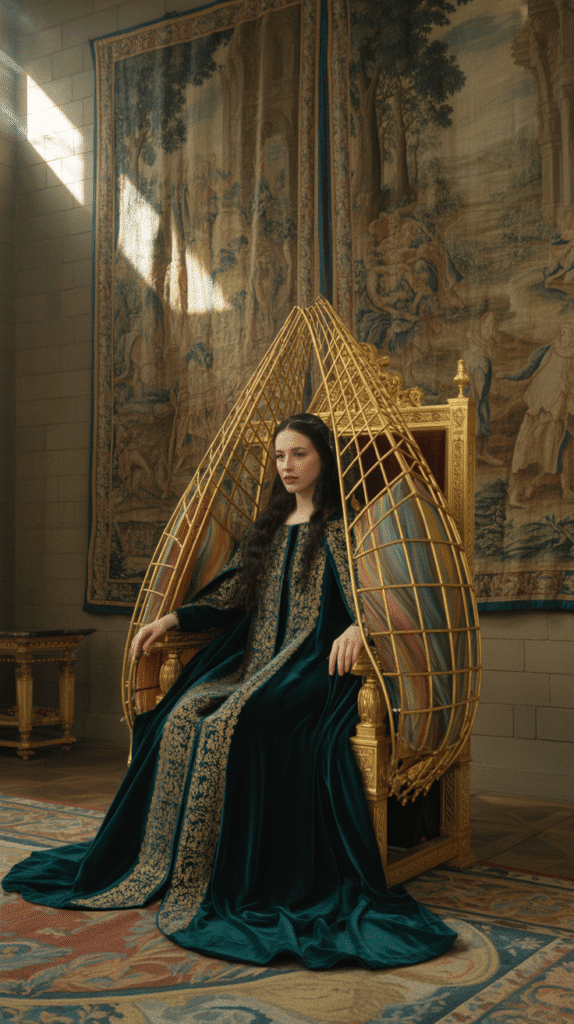
Wire or wicker frameworks covered with fabric or goldwork created geometric cages that enclosed the hair in dramatic sculptural shapes.
- Hair was arranged in buns, coils, or braids and then completely enclosed within the decorative framework.
- The reticulated (net-like) structure could be cone-shaped, cylindrical, or have multiple geometric protrusions.
- These elaborate headdresses were status symbols, showcasing wealth through materials and craftsmanship.
- The most ornate examples featured goldwork, jewels, and embroidery on silk or velvet coverings.
- This dramatic style required significant practice to wear with proper grace and posture.
25. Braided Headband with Loose Tresses
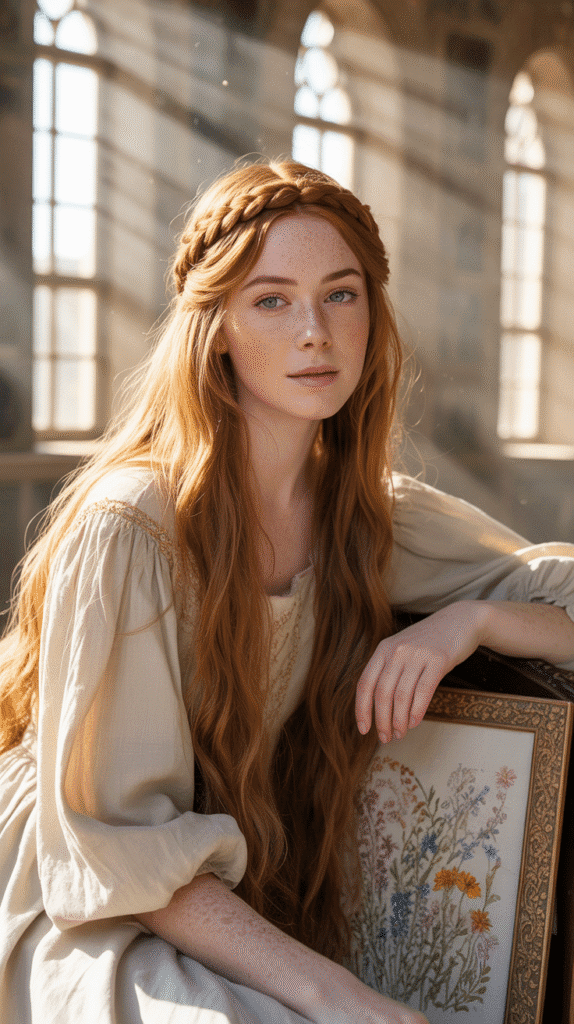
A braid created from the front sections of hair wraps around the head like a headband while the remaining hair flows freely.
- Small sections from each temple are braided together and wrapped across the crown from ear to ear.
- The braid acts as a natural headband, keeping hair away from the face without additional accessories.
- All remaining hair flows loosely down the back in natural waves or curls.
- This simple yet elegant style was popular for daily wear among younger noblewomen.
- Flowers or small decorative pins could be added to the braided headband section for special occasions.
26. The Burgundian Turban Style
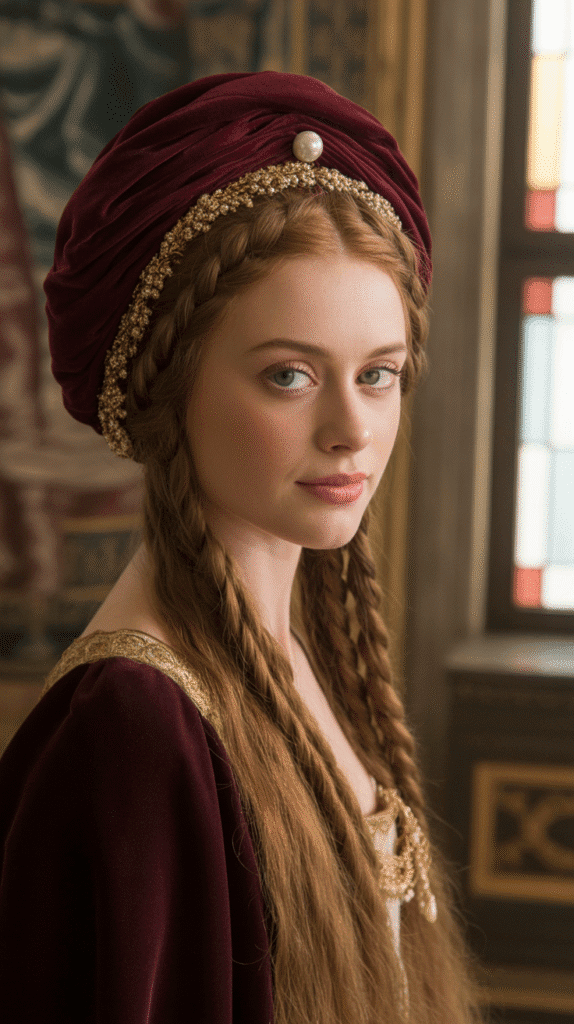
Fabric wrapped elaborately around the head in turban fashion, sometimes incorporating padded shapes, characterized late medieval Burgundian fashion.
- Long pieces of fabric were wrapped around the head in complex patterns, completely concealing the hair.
- Padded foundations gave structure and height to the wrapped fabric, creating distinctive silhouettes.
- The fabric ends were tucked and pinned to create smooth, sculptural forms.
- This sophisticated style required skill to execute and maintain throughout the day.
- The turbans were often made from luxurious materials like silk, velvet, or cloth of gold.
27. Asymmetrical Braided Updo
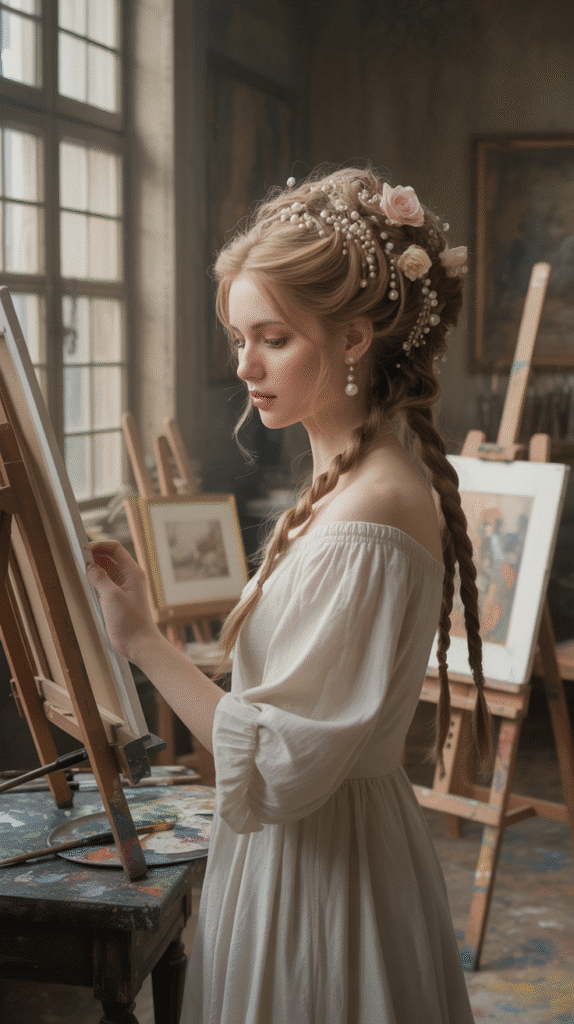
Multiple braids of varying sizes pinned up asymmetrically create a dynamic, artistic hairstyle that breaks from medieval symmetry traditions.
- Several braids are created in different thicknesses and arranged in an deliberately uneven pattern.
- The braids are pinned up in a loose, artistic manner that appears effortless yet intentional.
- This creative style allows for personal expression while maintaining medieval braiding techniques.
- Decorative pins, flowers, or small jewels can be added throughout for embellishment.
- The asymmetrical approach creates visual interest from every angle.
Conclusion
From the simple elegance of flowing tresses adorned with circlets to the architectural magnificence of hennins and reticulated headdresses, 27 Creative Medieval Hairstyle Ideas for Princesses reveals the extraordinary artistry that defined centuries of royal beauty.
These hairstyles were far more than mere fashion—they were expressions of identity, status, and the cultural values of medieval society, where a woman’s hair represented her virtue, family heritage, and social position.
Whether you’re drawn to the romantic simplicity of flower-crowned maidens dancing in spring meadows or the sophisticated complexity of jeweled braided updos fit for throne room ceremonies, there’s a medieval princess hairstyle perfectly suited to your vision and skill level.
Modern enthusiasts can recreate these timeless looks for Renaissance faires, medieval weddings, costume events, theatrical productions, or simply to experience the transformative magic of historical beauty.
The techniques explored here—from basic three-strand braids to elaborate coiled constructions—connect us directly to the ladies’ maids and noblewomen who perfected these arts in castle chambers lit by candlelight.
As you experiment with these styles, remember that medieval beauty celebrated patience, craftsmanship, and attention to detail, values that transform the simple act of styling hair into an art form worthy of princesses.
May these ideas inspire you to create your own royal moments and discover the queen within.Retry